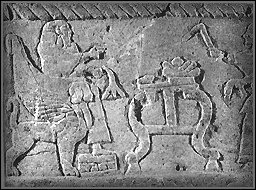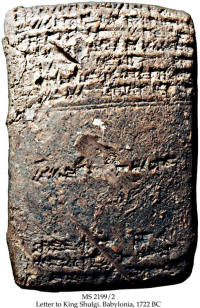| The 3rd Dynasty of Ur (2112-2004 BC) |
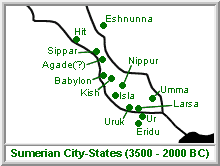 |
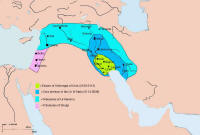 The
Third Dynasty of Ur refers simultaneously to a Sumerian ruling
dynasty based in the city of Ur and a short-lived
territorial-political state that some historians regard as a nascent
empire. The Third Dynasty of Ur is commonly abbreviated as Ur III by
historians of the period. The dynasty is also known as the Sumerian
Renaissance or the Ur III Empire. The
Third Dynasty of Ur refers simultaneously to a Sumerian ruling
dynasty based in the city of Ur and a short-lived
territorial-political state that some historians regard as a nascent
empire. The Third Dynasty of Ur is commonly abbreviated as Ur III by
historians of the period. The dynasty is also known as the Sumerian
Renaissance or the Ur III Empire.The Third Dynasty of Ur came to preeminent power in Mesopotamia after several centuries of Akkadian and Gutian kings. It controlled the cities of Isin, Larsa and Eshnunna and extended as far north as the Jezira. History The Third Dynasty of Ur arose soon after the fall of the Akkad Dynasty. The period between the last king of the Akkad Dynasty, Shar-kali-sharri, and the first king of Ur III, Ur-Nammu, is not well documented, but most Assyriologists posit that there was a power struggle among the most powerful city-states. Even the precise events surrounding the rise of Ur III are unclear. There are several theories. One theory is that Ur-Nammu (originally a general) founded the dynasty. In this line of thinking, he had supplanted the king of Uruk, Utu-khegal (sometimes called Utu-hegal), who himself had unseated the Gutian king Tirigan. The Sumerian king list tells us that Utu-hegal reigned for seven years, although the list itself is not to be taken literally as a historical source. This has been the most traditional way of thinking about the rise of Ur III, but other archaeological and documentary evidence has been found that sheds some new light on the situation. In another theory that is gaining prominence, Utu-hegal ruled Uruk while Ur-Nammu was his governor. There are two stelae discovered in Ur that include this detail in an inscription about Ur-Nammu's life. Harkening back to the first theory, some scholars theorize that Ur-Nammu led a revolt against Utu-hegal, deposed him, and gained control of the region through force. Another theory, however, is that Ur-Nammu was a close relative to Utu-hegal, and the latter had asked the former to rule over the city of Ur in his name. After four years of ruling in Ur, Ur-Nammu rose to prominence as a warrior-king when he crushed the ruler of Lagash in battle, killing the king himself. After this battle, Ur-Nammu seems to have earned the title 'king of Sumer and Agade.' The details of how the kingdom switched hands are unclear, but some scholars oppose the idea that Ur-Nammu staged a hostile takeover. For one thing, Ur and Uruk continued to foster, seemingly uninterrupted, a close relationship. Also, Mesopotamian kings tended to disparage publicly any rulers they were able to defeat, but no such evidence exists to show that Ur-Nammu fought against Utu-hegal. Assyriologists are always incorporating new evidence, and it is likely that new details will be found in the future. Assyriologists employ many complicated methods for establishing the most precise dates possible for this period, but controversy still exists. Generally, scholars use either the conventional or the low chronologies. They are as follows: Conventional Utu-hegal: 2119-2113 Ur-Nammu: 2212-c. 2095 Shulgi: 2094-2047 Amar-Sin: 2046-2037 Shu-Sin: 2037-2027 Ibbi-Sin: 2026-2004? Low |
|
| Kings of Ur | |
|
Ur-Nammu (17) 2112-2095 |
|
( r-näm´ r-näm´ ) (KEY) ,
fl. 2060 B.C., king of the ancient city of
Ur, sometimes called Zur-Nammu or Ur-Engur. He founded a new
Sumerian dynasty, the third dynasty of Ur, that lasted a century.
Ur-Nammu was the promulgator of the oldest code of law yet known,
older by about three centuries than the code of Hammurabi. It
consists of a prologue and seven laws; the prologue describes
Ur-Nammu as a divinely appointed king who established justice
throughout the land. This code is of great importance to the study
of biblical law, which it predates by about five centuries. The two
most famous monuments of Ur-Nammu’s reign are the great ziggurat
(temple) at Ur and his stele, of which fragments remain. ) (KEY) ,
fl. 2060 B.C., king of the ancient city of
Ur, sometimes called Zur-Nammu or Ur-Engur. He founded a new
Sumerian dynasty, the third dynasty of Ur, that lasted a century.
Ur-Nammu was the promulgator of the oldest code of law yet known,
older by about three centuries than the code of Hammurabi. It
consists of a prologue and seven laws; the prologue describes
Ur-Nammu as a divinely appointed king who established justice
throughout the land. This code is of great importance to the study
of biblical law, which it predates by about five centuries. The two
most famous monuments of Ur-Nammu’s reign are the great ziggurat
(temple) at Ur and his stele, of which fragments remain.The Columbia Encyclopedia, Sixth Edition. Copyright © 2001-05 Columbia University Press. 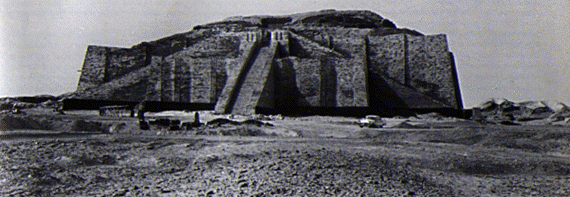 The ziggurat (and temple?) of
Ur-Nammu
The ziggurat (and temple?) of
Ur-Nammu
|
|
|
Shulgi (47) 2094-2047 |
|
| Shulgi of Urim is the second king of the "Sumerian
Renaissance". He reigned for 48 years, dated to 2094 BC–2047 BC
short chronology (also tentatively dated to 2161 BC–2113 BC on the
basis of a solar eclipse). Shulgi is best known for his extensive
revision of the scribal school's curriculum. Although it is unclear
how much he actually wrote, there are numerous praise poems written
by and directed towards this ruler. Shulgi was the son of Ur-Nammu king of Ur. He claimed himself a God, and boasted about his ability to maintain high speeds while running long distances. For example he claimed he once ran from Ur to Nippur in 2 hours, a distance of not less than 100 miles. He was most probably a demigod like Heracles or Gilgamesh. Kramer speaks of him as "The first long distance runner champion". It should come as no surprise the fact that Shulgi loved roads. He spent a great deal of time and resources in expanding, maintaining, and even making them more friendly to the traveler, this last he accomplished by building rest houses along the road, so that the traveler could find a place where he could rest and drink fresh water or spend a night. For this last feat Samuel Noah Kramer calls him the builder of the First Inn. Shulgi -2100-2000BC- son of Urnammu, He is an important king known from odes in later texts. He was the Maecenas (patron of arts) of the Sumerian language and promoted the canonization of Sumerian literature.
He had his poets and scribes publicize all sorts of stories about his prowess: he had complete mastery of every weapon of war, could capture gazelles on the run, slay lions unaided, and play every known musical instrument. |
|
|
Amar-Sin (9) 2046-2037 |
|
| Amar-Sin (2046-2037)-Son of Shulgi. He waged numerous campaigns against the Amorites. His time was divided between building projects and wars in Assyria against the Hurrians. He may have lost the Syrian and Elamite tributaries. He had himself deified and called the "God who gives life to the Country" and the "Sun-God [i.e. judge] of the Land". He died of an infection, which is ironic, since illness was seen as a sign of the displeasure of the gods. | |
|
Shu-Sin (9) 2037-2027 |
|
| Shu-Sin (2037-2027)-Brother of Amar-Sin. He also had himself deified. More wars were fought with the Amorites. He lost Assyria and erected a huge wall between the Tigris and the Euphrates a little north of Babylon in order to help contain the Amorites. The wall was 270 km long and breached the banks of both rivers. He also campaigned in the Zagros and defeated a coalition of Iranian tribes. He had extensive trade relations with the Indus Valley civilization. | |
|
Ibbi-Sin (24) 2026-2004? |
|
| Ibbi-Sin (2026-2004)-Son of Shu-Sin. The last king of Ur. New attacks by Elamites and Amorites forced the erection of new walls around Ur and Nippur. His situation was insecure and even pathetic throughout much of his reign. The realm began to disintegrate almost immediately. Much of the time he was confined to Ur itself. Eshnunna broke away in 2028 and Elam the next year. The Ensis of most of his cities deserted him and fended for themselves against the Amorites who were ravaging Sumer. He put a servant, Ishbi-Erra, in charge of Nippur and Isin. Ishbi-Erra in turn extended his sway along the rivers from Hamazi to the Persian Gulf. He took prisoner Ibbi- Sin's Ensis and installed his own. He did all of this while Ibbi-Sin was still on the throne. Severe famine and economic collapse ensued. Finally the Elamites sacked Ur, taking him prisoner, and ending the Empire. He died in Elam. | |
|
Back to the TimeLine Page Timeline 2210-2090 BC (Abraham Part 1) Back to the Bible Page Back to Chip off the Old Rock |
|
